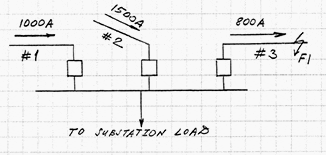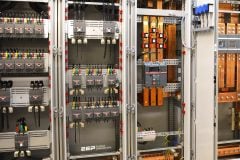Let’s choose 138 kV line #3 circuit breaker
To better understand a process of high voltage equipment selection, let’s discuss an example of choosing 138 kV Line #3 Circuit Breaker, shown in Figure 1, assuming that the following information about the system is available:

The following information about the system is available:

Continuous current for all the lines:
- Line #1 – 1,000 A,
- Line #2 – 1,500 A,
- Line #3 – 800A
3-phase fault current on the bus is 46.5 kA, contributions from the lines:
- Line #1 – 24.5 kA,
- Line#2 – 12kA,
- Line#3 – 10kA
Projected Substation load growth is 25%.
Available breaker ratings:
- Continuous current: 1,200 A, 2,000 A, 3,000 A
- Short circuit interrupting capability: 40 kA, 50 kA
Let’s see the solution…
Future load considering 25% growth: (1000 A + 1500 A – 800 A) x 1.25 = 2,125 A.
This load may be fed from Line #3 through its circuit breaker if lines #1 and #2 are switched off. So, the breaker should be sized to carry at least 2,125 A. Closest available continuous rating meeting this requirement is 3,000 A.
Maximum 3-phase fault current that Line #3 breaker needs to interrupt may be calculated by deducting from a total bus fault current a contribution from line #3, i.e. 46.5 – 10 = 36.5 kA
Closest short circuit current interrupting rating and meeting requirement to be at least 36.5 kA is 40 kA.
This is a summary of the selected circuit breaker ratings:
- Rated maximum voltage – 138 kV
- Rated continuous current – 3,000 A
- BIL – 650 kV
- Rated short circuit current – 40 kA
As you can see, selection of equipment for a specific application requires an input data which may be obtained from system studies. Such data include power flows, load projection, short circuit current calculations, etc., which are usually performed by utility company planners.
Reference: Fundamentals of Modern Electrical Substations (Part 3: Electrical Substation Engineering Aspects) – Boris Shvartsberg, Ph.D., P.E., P.M.P.











Very nice explaination
Edvard in calculating Future load considering 25% growth: (1000 A + 1500 A – 800 A) x 1.25 why you use -800 its not clear. if this calculation for line #3, we have Continuous current for Line #3 = 800A!
hello methaq…i think apply KCL in that grid…you will get (1000 A + 1500 A – 800 A) these value.
Hello;
please pay attention to direction of currents.in #3 is differ from #1 & #2.
Good luck.